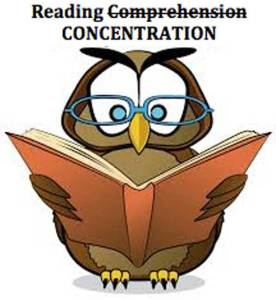 Reading comprehension tests are, in most cases, a misnomer. Passages on the SAT, ACT, Literature Subject Test, and AP English exams do not typically test students’ ability to COMPREHEND the material; they test students’ ability to pay attention to what they’re reading. This is a very important distinction, particularly when it comes to confidence. When students perform poorly on a reading comprehension test, or at a level less than they’d expect, the reason is not likely that they can’t COMPREHEND the passage, but rather than they weren’t paying close enough attention; that is, they weren’t concentrating on what they were reading. It’s analogous to when you’re in a class at school and, for a brief period of time, you notice something bright and shiny out the window and focus on that while the teacher is explaining some new idea. Just then, the teacher notices you’re gazing out the window and says, “Joe, can you explain to the class the idea I just presented.” Your inability to comply with the teacher’s request doesn’t reflect your inability to COMPREHEND what the teacher said, it’s just that you weren’t listening for a second.
Reading comprehension tests are, in most cases, a misnomer. Passages on the SAT, ACT, Literature Subject Test, and AP English exams do not typically test students’ ability to COMPREHEND the material; they test students’ ability to pay attention to what they’re reading. This is a very important distinction, particularly when it comes to confidence. When students perform poorly on a reading comprehension test, or at a level less than they’d expect, the reason is not likely that they can’t COMPREHEND the passage, but rather than they weren’t paying close enough attention; that is, they weren’t concentrating on what they were reading. It’s analogous to when you’re in a class at school and, for a brief period of time, you notice something bright and shiny out the window and focus on that while the teacher is explaining some new idea. Just then, the teacher notices you’re gazing out the window and says, “Joe, can you explain to the class the idea I just presented.” Your inability to comply with the teacher’s request doesn’t reflect your inability to COMPREHEND what the teacher said, it’s just that you weren’t listening for a second.
We’ve all had the experience of reading down a whole column of text, whether in a newspaper article, website, or homework assignment, and suddenly realize that even though we’re pretty sure we read every single word, we have absolutely no idea what the passage is about. And because high-stakes, standardized tests only raise the ante on nervousness and text anxiety, this phenomenon—our challenge with paying attention to what we’re reading—is even more common just when we need to focus the most.
So what’s a reading comprehension test taker to do? Good question, glad you asked.
- Stop worrying about reading COMPREHENSION (trust me, you have the cognitive firepower to comprehend whatever they throw at you) and start thinking reading CONCENTRATION. Think about what it will take to maximize your focus and attention for the length of time it takes to read the passage. Typically, that means being in the here and now, rather than the then and there—”then” being the past or the future, “there” being anywhere but where you’re feet are. That is, when we read without concentration—when we realize half-way through we haven’t really comprehended anything—the reason is that our thoughts are bound up in something that already happened (maybe earlier that day or week or lifetime) or that we imagine is going to happen (maybe as a result of not paying attention right now!). Recognizing this natural human tendency to generate thoughts—after all, that’s what we pay our brains to do—is half the battle, and the other half is managing those wandering, monkey-brain thoughts. The wrong way to manage them is what I used to do: yell at yourself (silently, of course) and tell yourself to pay attention! focus! right now! this is important! The right, effective way to do it is simply to notice your thoughts are wandering and gently, NON-JUDGMENTALLY, bring your attention back to the here and now. At CPE we apply techniques from Mindfulness to the test-taking experience in our Academic Stress and Test Anxiety Workshops.
- Even better, give your active mind something more productive to focus on, namely the passage at hand. The best way to do this is by actively reading, underlining key words, that is, whichever words you think are important (names, places, dates, main ideas). The good news is that it doesn’t really matter which words you underline, only that you underline. The very act of underlining INDIVIDUAL WORDS, rather than whole sentences (which allows our thoughts to start wandering again) engages reading comprehension, what we ed-school types refer to as “meta-cognition,” or thinking about what we’re thinking (really, in this context, it’s just a fancy word for….reading comprehension). When we’re thinking about what we’re reading, which is what we FORCE ourselves to do when we underline individual words, we are concentrating on the material and we AUTOMATICALLY read with much greater comprehension (which is, um, what they’re testing us on). I have had COUNTLESS students who used to struggle mightily with reading comprehension tests, then try this simple technique, and IMMEDIATELY jump up 100 or more points on the SAT Critical Reading and a couple of points or more on the Reading Test on the ACT. TRY IT!
Check out CPE’s PSAT, SAT, ACT, Subject Test, and AP Review Classes and our Class Schedule and Registration, and learn and practice strategies like these.
